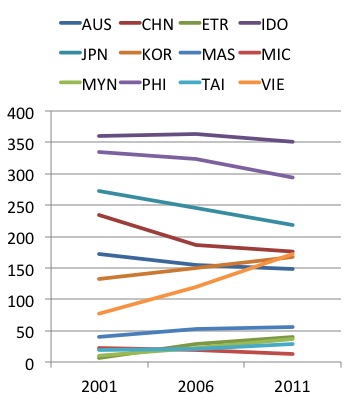The Society is now at a new stage brought about by a couple of converging factors – the demographic realities and how we can best serve the universal mission today.
Our numbers have been in decline for the last 40 years – from over 30,000 in the 1960s to fewer than 18,000 today. The steep declines in Europe and North America and consistent decline in Latin America have not been offset by the significant increase in South Asia and a small rise in Africa.
Here in Asia Pacific, our numbers have held steady for the past 25 years and look likely to do so in the next 25 years. But this constant total number belies the enormous changes going on within our various provinces and its impact on how we continue to carry out our universal mission.
We are seeing significant demographic change from province to province. Some are growing rapidly, especially Vietnam, which had around 70 members at the turn of the century and can be expected to reach over 300 within 25 years. The Korean Province is growing spectacularly, while Myanmar and Timor Leste evidence significant increases. Thailand and Malaysia reveal new life, and Indonesia, our largest province, is holding steady. However our numbers in Australia, China, Japan and the Philippines are declining in numbers and ageing.

As the customary (Western) sources of “personnel” dries up, pressure is put on other parts of the world to supply key people for international roles, as well as for key leadership, administration and teaching roles in its international institutions. Even if we don’t have people readily available, we in Asia Pacific are still expected to supply them.
All this demonstrates the need for greater cooperation across provinces in distributing personnel according to the needs, as well as a re-evaluation of our governance arrangements.
It would be wasteful and inappropriate to maintain the same support services for a body of 100 that were formally deployed to back up say 400 Jesuits. It is also timely to review our province frontiers, which through convenience and historical circumstance, are contiguous with national boundaries.
As an international body, we should not remain cocooned in provincial arrangements developed in a former era. Although national identities and local insertion frequently lead to efficiencies, local enculturation and a universal vision are not mutually exclusive. Teams and communities of Jesuits and their collaborators are frequently international in character and can be deeply inserted in very localised cultural settings.
In parts of the world where there has been dramatic demographic change among Jesuits, there have been some interesting examples of re-organisation. Five or six Spanish provinces are becoming one. The 10 provinces of the United States are re-configuring their ways of cooperating and halving the number of support centres that handle finances, personnel support and apostolic planning. The Jesuits in the Scandinavian countries, Germany, Austria and Switzerland, at one stage four or five separate Jesuit provinces, cooperate now in apostolic planning. Ireland, Britain, Netherlands and the Flemish speaking Jesuits from Belgium are evolving a cooperative structure.
In Asia Pacific, which is perhaps the most diverse part of the Society in terms of languages, cultures and political entities, cooperation among provinces has been impressive. Examples of common projects include a recent agreement for mutual support between Japan and Korea and the adoption by Korea of the mission in Cambodia. Vietnamese Jesuits have worked in a Korean centre that supports migrant workers.
There is the traditional witness throughout Asia Pacific of those who go as missionaries to live with another people. Many Australian, Indonesian and Korean Jesuits serve on missions outside their countries of origin, and a great number of the Jesuits serving in Cambodia, Thailand, Micronesia, Timor Leste, Myanmar, China and Japan are from abroad.
The major factor, however, must be the re-emphasis given by GC 35 to the Society as “a universal body in service of a universal mission”. Numbers may be relevant, but the mission is far more important. The mission is universal and the body that serves this mission is universal. No one can or should completely slough off national identity, but our identity as Jesuits gives us reason to go beyond national or local boundaries. Jesuit identity should trump national identity. Fr Arrupe foresaw this 40 years ago, when at GC 31 he called on Jesuits to “break down the walls between the provinces”.
Ignatius did not want the Society to be the biggest or most prestigious religious community. He wanted a body of men prepared and disposed to go wherever the need is greatest. This perception influences greatly how we undertake our mission in today’s world and how we prepare for it.
Mark Raper SJ
May 19, 2012
A complementary article was published in Province Express. To read The changing face of the Jesuits, click here.


